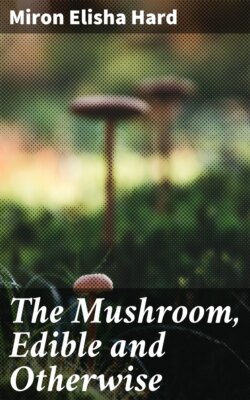Читать книгу The Mushroom, Edible and Otherwise - Miron Elisha Hard - Страница 3
На сайте Литреса книга снята с продажи.
INTRODUCTION
ОглавлениеTable of Contents
I would agree with those who might maintain that no Introduction is needed for this book on mushrooms. Nevertheless a word may not be out of place for the inception of the work is out of the ordinary. Mr. Hard did not decide that a book on this subject was needed and then set about studying these interesting plants. He has observed them, collected them, induced many friends to join in eating those which proved to be palatable and delicious—really meddled for years with the various kinds which are edible and otherwise, and then recently he has decided to publish a book on his favorite subject. The interesting occupation of photographing the mushrooms and the toadstools doubtless has contributed largely to the determination culminating in the materialization of the treatise.
If I have correctly apprehended the origin and the contributing causes, we would expect this book to be different from the other books on mushrooms—not of course in scope and purpose; but the instruction and suggestions given, the descriptions and general remarks offered, the wide range of forms depicted in word and picture, the whole make up of the book in fact, will appeal to the people at large rather than the college student in particular. The author does not write for the specially educated few, but for the mass of intelligent people—those who read and study, but who observe more; those who are inclined to commune with nature as she displays herself in the glens and glades, in the fields and forests, and who spend little, if any, time chasing the forms or sketching the tissues that may be seen on the narrow stage of a compound microscope.
The book then is for the beginner, and for all beginners; the college student will find that this is the guide to use when he is ready to begin studying the mushrooms; the teachers in the schools should all begin to study mushrooms now, and for the purpose they will find this book advantageous; the people who see mushrooms often but do not know them may find here a book that really is a help.
We might wish for color photography when the subject is a delicately tinted mushroom; but if with it we should lose detail in structure then the wish would be renounced. The colors can be, approximately, described, often not so the characteristic markings, shapes and forms. The halftones from the photographs will, we anticipate, prove a valuable feature of the book, especially if the plants be most carefully examined before turning to the pictures. For half an hour the pages may be turned and the illustrations enjoyed. That, however, would give one no real knowledge of mushrooms. If such use only is made of the pictures, better had they never been prepared by Mr. Hard and his friends. But if a charming little toadstool, a delicately colored mushroom, a stately agaric, be carefully removed from the bed of loam, the decaying stump, or the old tree-trunk, then turned over and over again, and upside down, every part scrutinized, the structure in every detail attentively regarded—not with repugnant feeling, rather with a sympathetic interest that should naturally find all organisms inhabiting our globe—then in due time coming to the picture, a real picture, in the book, it must surely bring both pleasure and profit. Ponder the suggestion. Then, to conclude in a word, if Mr. Hard's book will induce people to learn and enjoy the mushrooms that we have, it will be a success, and great will be his reward.
W. A. Kellerman, Ph. D.
Botanical Department,
Ohio State University,
Columbus, O.
